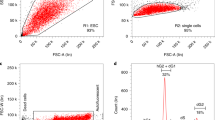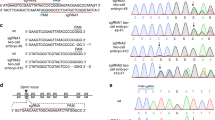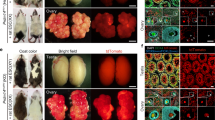Abstract
We have devised a general strategy for producing female mice from 39,X0 embryonic stem (ES) cells derived from male cell lines carrying a targeted mutation of interest. We show that the Y chromosome is lost in 2% of subclones from 40,XY ES cell lines, making the identification of targeted 39,X0 subclones a routine procedure. After gene targeting, male and female mice carrying the mutation can be generated by tetraploid embryo complementation from the 40,XY ES cell line and its 39,X0 derivatives. A single intercross then produces homozygous mutant offspring. Because this strategy avoids outcrossing and therefore segregation of mutant alleles introduced into the ES cells, the time and expense required for production of experimental mutant animals from a targeted ES cell clone are substantially reduced. Our data also indicate that ES cells have inherently unstable karyotypes, but this instability does not interfere with production of adult ES cell–tetraploid mice.
This is a preview of subscription content, access via your institution
Access options
Subscribe to this journal
Receive 12 print issues and online access
$209.00 per year
only $17.42 per issue
Buy this article
- Purchase on Springer Link
- Instant access to full article PDF
Prices may be subject to local taxes which are calculated during checkout



Similar content being viewed by others
References
Gu, H., Marth, J.D., Orban, P.C., Mossmann, H. & Rajewsky, K. Deletion of a DNA polymerase β gene segment in T cells using cell type-specific gene targeting. Science 265, 103–106 (1994).
Rodriguez, C.I. et al. High-efficiency deleter mice show that FLPe is an alternative to Cre-loxP. Nat. Genet. 25, 139–140 (2000).
Lakso, M. et al. Targeted oncogene activation by site-specific recombination in transgenic mice. Proc. Natl. Acad. Sci. USA 89, 6232–6236 (1992).
Minichiello, L. et al. Essential role for TrkB receptors in hippocampus-mediated learning. Neuron 24, 401–414 (1999).
Shibata, H. et al. Rapid colorectal adenoma formation initiated by conditional targeting of the Apc gene. Science 278, 120–123 (1997).
Eggan, K. et al. Hybrid vigor, fetal overgrowth, and viability of mice derived by nuclear cloning and tetraploid embryo complementation. Proc. Natl. Acad. Sci. USA 98, 6209–6214 (2001).
Nagy, A., Rossant, J., Nagy, R., Abramow-Newerly, W. & Roder, J.C. Derivation of completely cell culture-derived mice from early-passage embryonic stem cells. Proc. Natl. Acad. Sci. USA 90, 8424–8428 (1993).
Cattanach, B. X0 Mice. Genet. Res. 3, 487–490 (1962).
Lamar, E.E. & Palmer, E. Y-encoded, species-specific DNA in mice: evidence that the Y chromosome exists in two polymorphic forms in inbred strains. Cell 37, 171–177 (1984).
Passemato, R., Eggan, K., Moeller, B., Jaenisch, R. & Jackson-Grusby, L. Flp recombinase regulated lacz expression at the ROSA26 locus. Genesis. 32, 184–186 (2002).
Jentsch, I., Adler, I.D., Carter, N.P. & Speicher, M.R. Karyotyping mouse chromosomes by multiplex-FISH (M-FISH). Chromosome Res. 9, 211–214 (2001).
Brook, J.D. X-chromosome segregation, maternal age and aneuploidy in the X0 mouse. Genet. Res. 41, 85–95 (1983).
Al-Shawi, R. et al. The herpes simplex virus type 1 thymidine kinase is expressed in the testes of transgenic mice under the control of a cryptic promoter. Mol. Cell. Biol. 11, 4207–4216 (1991).
Wang, P.J., McCarrey, J.R., Yang, F. & Page, D.C. An abundance of X-linked genes expressed in spermatogonia. Nat. Genet. 27, 422–426 (2001).
Marahrens, Y., Panning, B., Dausman, J., Strauss, W. & Jaenisch, R. Xist-deficient mice are defective in dosage compensation but not spermatogenesis. Genes. Dev. 11, 156–166 (1997).
Liu, X. et al. Trisomy eight in ES cells is a common potential problem in gene targeting and interferes with germ line transmission. Dev. Dyn. 209, 85–91 (1997).
Hogan, B. et al. Isolation, culture, and manipulation of embryonic stem cells. In Manipulating the Mouse Embryo. (eds Hogan, B., Beddington, R., Constantini, F. and Lacy, E.) 253–289 (Cold Spring Harbor Laboratory Press, Cold Spring Harbor, NY; 1994).
Bishop, C.E. & Hatat, D. Molecular cloning and sequence analysis of a mouse Y chromosome RNA transcript expressed in the testis. Nucleic Acids Res. 15, 2959–2969 (1987).
Soriano, P. Generalized lacZ expression with the ROSA26 Cre reporter strain. Nat. Genet. 21, 70–71 (1999).
Laird, P.W. et al. Simplified mammalian DNA isolation procedure. Nucleic Acids Res. 19, 4293 (1991).
Acknowledgements
We would like to thank D. Page, W.M. Rideout, C. Beard, K. Hochedlinger, A. Bortvin, M. Rios, and D. Menke for helpful discussions. This work was supported in part by NIH grants 5-R35-CA44339 and RO1-CA84198 to R. Jaenisch. I. Jentsch received a stipend from TILL I.D., Gräfeling, Germany.
Author information
Authors and Affiliations
Corresponding author
Ethics declarations
Competing interests
A.R., C.S., T.H., H.T., B.Z., and R.K. are employed by Artemis Pharmaceuticals, Cologne, and will use some of the results reported here for their ongoing commercial interests. The remaining authors are all at academic institutions that are supported by public funds and have no competing interests in this research.
Supplementary information
Rights and permissions
About this article
Cite this article
Eggan, K., Rode, A., Jentsch, I. et al. Male and female mice derived from the same embryonic stem cell clone by tetraploid embryo complementation. Nat Biotechnol 20, 455–459 (2002). https://doi.org/10.1038/nbt0502-455
Received:
Accepted:
Issue Date:
DOI: https://doi.org/10.1038/nbt0502-455
This article is cited by
-
Generation of functional oocytes from male mice in vitro
Nature (2023)
-
Eggs made from male mouse stem cells using error-prone culture
Nature (2023)
-
Healthy cloned offspring derived from freeze-dried somatic cells
Nature Communications (2022)
-
Elevated retrotransposon activity and genomic instability in primed pluripotent stem cells
Genome Biology (2021)
-
Depletion of aneuploid cells in human embryos and gastruloids
Nature Cell Biology (2021)



